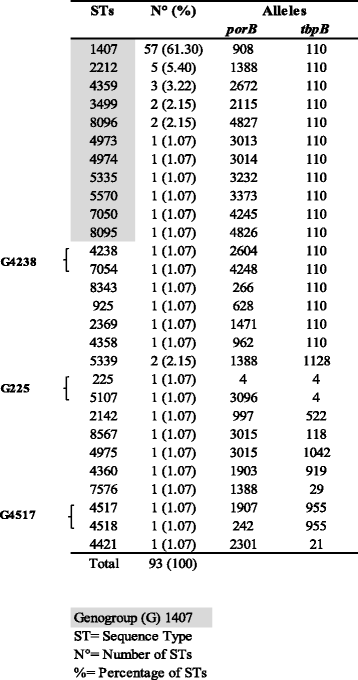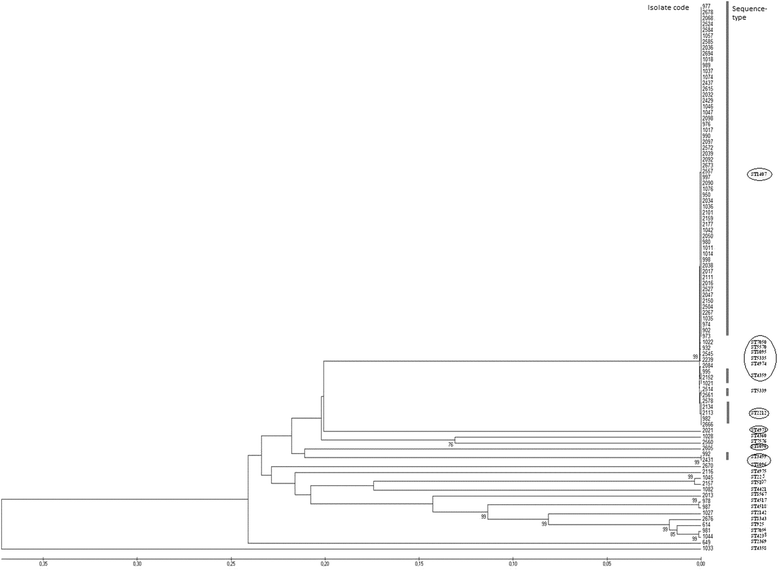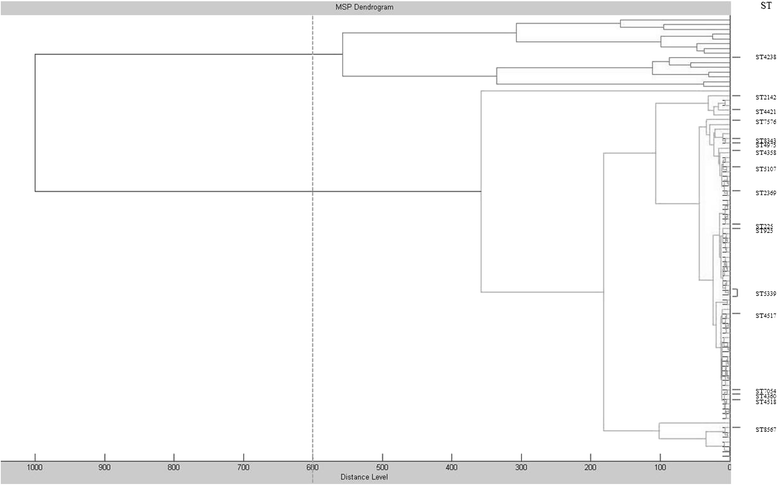Evaluation of matrix-assisted laser desorption ionization-time of flight mass spectrometry (MALDI-TOF MS) for identification and clustering of Neisseria gonorrhoeae
- PMID: 26205172
- PMCID: PMC4514454
- DOI: 10.1186/s12866-015-0480-y
Evaluation of matrix-assisted laser desorption ionization-time of flight mass spectrometry (MALDI-TOF MS) for identification and clustering of Neisseria gonorrhoeae
Abstract
Background: The sexually transmitted infection gonorrhea remains a public health concern for becoming resistant to drug treatments available. The purpose of this study was to evaluate the usefulness of the matrix-assisted laser desorption ionization-time of flight mass spectrometry (MALDI-TOF MS) to identify and cluster Neisseria gonorrhoeae. From a current monitoring in Italy, as part of the European Gonococcal Antimicrobial Surveillance Programme (EURO-GASP), 93 gonococci collected from 2007 to 2012 susceptible (44 isolates) and resistant (49 isolates) to cefixime were selected. Minimum Inhibitory Concentration (MIC) values for cefixime was assessed by Etest carried out in agreement with the manufacturer's instructions and interpreted referring to European Committee on Antimicrobial Susceptibility testing (EUCAST) clinical breakpoints criteria. Data obtained by N. gonorrhoeae multiantigen sequence typing (NG-MAST) and the dendrogram based on the concatenation of porB and tbpB genes were evaluated. MALDI-TOF MS, to reconfirm gonorrhea identification, analyzed single colonies from freshly grown isolates and applied directly on a ground-steel MALDI target plate. For the MALDI-TOF dendrogram cluster analysis, MSPs (Main Spectrum Profile) from each isolate were created acquiring 5000 shots from 10 technical replicates obtained from bacteria extraction.
Results: Molecular typing by NG-MAST showed 28 sequence types (STs); G1407 was the predominant accounting for 75 gonococci. All the 93 gonococci, except one, were correctly identified at species level by MALDI-TOF MS and G1407 isolates were divided into two clusters.
Conclusion: MALDI-TOF MS for a real-time detection and cluster analysis of gonorrhea is a promising tool for surveillance purposes. Moreover, additional studies are required to collect more data on the performance of MALDI-TOF MS for gonococci.
Figures



References
-
- World Health Organization (WHO) Department of Reproductive Health and Research. Global incidence and prevalence of selected curable sexually transmitted infections - 2008. Geneva, Switzerland: WHO; 2012.
-
- Cole MJ, Spiteri G, Chisholm SA, Hoffmann S, Ison CA, Unemo M, et al. Emerging cephalosporin and multidrug-resistant gonorrhea in Europe. Euro Surveill. 2014; 19:pii = 20955. http://www.eurosurveillance.org/ViewArticle.aspx?ArticleId=20955. - PubMed
-
- Ohnishi M, Golparian D, Shimuta K, Saika T, Hoshina S, Iwasaku K, et al. Is Neisseria gonorrhoeae initiating a future era of untreatable gonorrhea?: detailed characterization of the first strain with high-level resistance to ceftriaxone. Antimicrob Agents Chemother. 2011;55:3538–45. doi: 10.1128/AAC.00325-11. - DOI - PMC - PubMed
-
- European Centre for Disease Prevention and Control (ECDC). Surveillance report. Response plan to control and manage the threat to multidrug-resistance gonorrhoea in Europe. Stockholm, 2012. ECDC; 2012. http://www.ecdc.europa.eu/en/publications/Publications/1206-ECDC-MDR-gon...
Publication types
MeSH terms
Substances
LinkOut - more resources
Full Text Sources
Other Literature Sources

